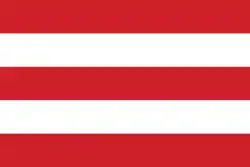Kingdom of Bora Bora
The Kingdom of Bora Bora was established during the early 19th century with the unification of the island of Bora Bora and official recognition by France and the United Kingdom in 1847 through the Jarnac Convention. It was one of a number of independent Polynesian states in the Society Islands, alongside Tahiti, Huahine and Raiatea in the 19th century, which all shared a similar language and culture and whose rulers were interrelated by marriage. Besides Bora Bora, the Kingdom encompassed the islands of Tupai, Maupiti, Maupihaa, Motu One, and Manuae. The Kingdom was finally annexed to France in 1888 and its last queen Teriimaevarua III was forced to abdicate in 1895.
Kingdom of Bora-Bora Royaume de Bora-Bora | |||||||
|---|---|---|---|---|---|---|---|
| Early 19th century–1895 | |||||||
.svg.png.webp)  Flag | |||||||
 | |||||||
| Capital | Nunue Vaitape | ||||||
| Common languages | |||||||
| Religion | Tahitian, Christianity | ||||||
| Government | Monarchy | ||||||
| Monarch | |||||||
• 1778–1812 | Tapoa I (first) | ||||||
• 1873-1895 | Teriimaevarua III (last) | ||||||
| History | |||||||
• Established | Early 19th century | ||||||
| 19 March 1888 | |||||||
• Abdication of Teriimaevarua III | 21 September 1895 | ||||||
| Currency | French franc Pound sterling | ||||||
| |||||||
| Today part of | |||||||
Bora Bora in ancient times: religious and military power
The history of Bora Bora is marked by the rivalry of two clans: one based near Faanui, consisting of families attached to the marae Farerua, and the other consisting of the families of Nunue and Anau around the marae Vaiotaha, which was long among the most important marae of Polynesia.
In this respect, Bora Bora is likewise marked by the rivalry with Raiatea in pursuit of religious power. Up to a certain period, a certain parallelism can be seen between the institutions of Bora Bora and Raiatea, which suggests that the two islands exercise joint religious and political authority over the other Leeward Islands. However, Raiatea ultimately became the center of religious power, while Bora-Bora retained a particularly strong military power, expressed both in internal wars and in wars with rival islands.
According to Tupaia, Borabora was actually a place of exile for thieves and other wrongdoers. However, the outcasts eventually became pirates, attacking the other islands in kind. In the 18th century a great chief, Puni (Teihotu Matarua), succeeded in dominating the island's other clans. He then conquered Tahaa before attacking Raiatea, which he conquered in 1763 after a three-year campaign. In 1769, when James Cook landed at Tahaa and Raiatea, the islands were still dominated by Puni and his Borabora warriors.[1]
At Puni's death, his nephew Tapoa I, paramount chief of Bora Bora, Raiatea and Tahaa, settled at Raiatea, thus leaving local power to the chiefs Mai and Tefaaora, originally of Nunue and Anau, and members of the marae of Vaiotaha.
The first clear mention of the island was by the Dutch explorer Jakob Roggeveen in 1722.[2] James Cook saw it in 1769 and landed there in 1777.
The end of independence
Family tree of monarchs
References
- Salmond, Anne (2010). Aphrodite's Island. Berkeley: University of California Press. pp. 36, 218, 286. ISBN 9780520261143.
- Tahiti et ses archipels par Pierre-Yves Toullelan, éditions Karthala, 1991, ISBN 2-86537-291-X, p. 61.